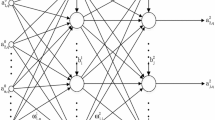Abstract
Stock market crashes bring about huge economic loss, so predicting the stock market crashes is extremely important for both the investors and practitioners. Back propagation (BP) neural network performed greatly in data adaptability and fitting, it has been widely used for forecasting study in various fields. However, given the low frequency and lack of periodicity of stock market crashes, the BP neural network can hardly predict the intensively fluctuated stock prices accurately during the crashes. To resolve this issue, we introduced BP neural network into Log-periodic power law model, proposed the Log-periodic power law hybrid model based on the BP neural network. This combined approach could further capture the fluctuation trend and predict the volatility during the stock market crashes better. The experimental results showed that this hybrid model could predict the stock prices in different stock markets with a slightly increased accuracy. Moreover, its performance was more stable compared with BP neural network.



Similar content being viewed by others
References
White LJ (2011) Preventing bubbles: What role for financial regulation? Working Pap 31(3):603–619
Agrawal JG, Chourasia V, Mittra A (2013) State-of-the-art in stock prediction techniques. Int J Adv Res Electr Electron Instrum Eng 2(4):1360–1366
Thenmozhi M, Chand GS (2016) Forecasting stock returns based on information transmission across global markets using support vector machines. Neural Comput Appl 27(4):805–824
Al-Askar H, Lamb D, Hussain AJ, Al-Jumeily D, Randles M, Fergus P (2015) Predicting financial time series data using artificial immune system–inspired neural networks. Int J Artif Intell Soft Comput 5(1):45–68
Żbikowski K (2015) Using volume weighted support vector machines with walk forward testing and feature selection for the purpose of creating stock trading strategy. Expert Syst Appl 42(4):1797–1805
Grigorievskiy A, Miche Y, Ventelä AM, Séverin E, Lendasse A (2014) Long-term time series prediction using OP-ELM. Neural Netw 51:50–56
de Oliveira FA, Zárate LE, de Azevedo RM, Nobre CN (2011) The use of artificial neural networks in the analysis and prediction of stock prices. In: 2011 IEEE international conference on systems, man, and cybernetics (SMC), pp 2151–2155. IEEE
Liu SH, Zhou F (2010) On stock prediction based on KNN-ANN algorithm. In: 2010 IEEE fifth international conference on bio-inspired computing: theories and applications (BIC-TA), pp 310–312. IEEE
Ke J, Liu X (2008) Empirical analysis of optimal hidden neurons in neural network modeling for stock prediction. In: 2008 IEEE Pacific-Asia workshop on computational intelligence and industrial application, pp 828–832. IEEE
Hsieh TJ, Hsiao HF, Yeh WC (2011) Forecasting stock markets using wavelet transforms and recurrent neural networks: an integrated system based on artificial bee colony algorithm. Appl Soft Comput 11(2):2510–2525
Yu LQ, Rong FS (2010) Stock market forecasting research based on neural network and pattern matching. In: 2010 international conference on E-business and E-government (ICEE), pp 1940–1943. IEEE
Tingsanchali T, Gautam MR (2000) Application of tank, NAM, ARMA and neural network models to flood forecasting. Hydrol Process 14(14):2473–2487
Gao JH, Li YX, Jiang H, Dong WY (2015) Evolutionary algorithm for self-exciting threshold autoregressive model. Int J Wirel Mobile Comput 8(3):229–235
Melnyk I, Matthews B, Valizadegan H, Banerjee A, Oza N (2016) Vector autoregressive model-based anomaly detection in aviation systems. J Aerosp Inf Syst 10:161–173
D’Urso P, De Giovanni L, Massari R (2016) GARCH-based robust clustering of time series. Fuzzy Sets Syst 305:1–28
Yetis Y, Kaplan H, Jamshidi M (2014) Stock market prediction by using artificial neural network. In: World Automation Congress (WAC). IEEE, pp 718–722
Rumelhart DE, Hinton GE, Williams RJ (1986) Learning representations by back-propagating errors. Nature 323(6088):533
Miao J, Wang P (2015) Banking bubbles and financial crises. J Econ Theory 157:763–792
Blanchard OJ, Watson MW (1982) Bubbles, rational expectations and financial markets
De Long JB, Shleifer A, Summers LH, Waldmann RJ (1990) Noise trader risk in financial markets. J Polit Econ 98(4):703–738
Ye Y, Chang T, Hung K, Lu YC (2011) Revisiting rational bubbles in the G-7 stock markets using the Fourier unit root test and the nonparametric rank test for cointegration. Math Comput Simul 82(2):346–357
Liu H, Jia T, Yuan C, Zhang Y (2012) Research on irrational bubbles in the stock market based on the perspective of generalized virtual economy. Kybernetes 41(7/8):897–907
Galí J, Gambetti L (2015) The effects of monetary policy on stock market bubbles: some evidence. Am Econ J Macroecon 7(1):233–257
Sornette D, Johansen A, Bouchaud JP (1996) Stock market crashes, precursors and replicas. J Phys I 6(1):167–175
Huerta R, Corbacho F, Elkan C (2013) Nonlinear support vector machines can systematically identify stocks with high and low future returns. Algorithmic Finance 2(1):45–58
Lai LK, Liu JN (2010) Stock forecasting using support vector machine. In: 2010 International Conference on Machine Learning and Cybernetic. IEEE, pp 1607-–1614
Geraskin P, Fantazzini D (2013) Everything you always wanted to know about log-periodic power laws for bubble modeling but were afraid to ask. Eur J Finance 19(5):366–391
Funding
This work was financially supported by the National Youth Science Foundation of China (No. 61503272), Key Research and Development Plan of Shanxi Province (201903D121151).
Author information
Authors and Affiliations
Corresponding author
Ethics declarations
Conflict of interest
The authors declare that they have no conflict of interest.
Additional information
Publisher's Note
Springer Nature remains neutral with regard to jurisdictional claims in published maps and institutional affiliations.
Rights and permissions
About this article
Cite this article
Wang, H., Liu, D., Zhang, J. et al. Log-periodic power law hybrid model based on BP neural network. Evol. Intel. 17, 123–131 (2024). https://doi.org/10.1007/s12065-020-00552-z
Received:
Revised:
Accepted:
Published:
Issue Date:
DOI: https://doi.org/10.1007/s12065-020-00552-z




